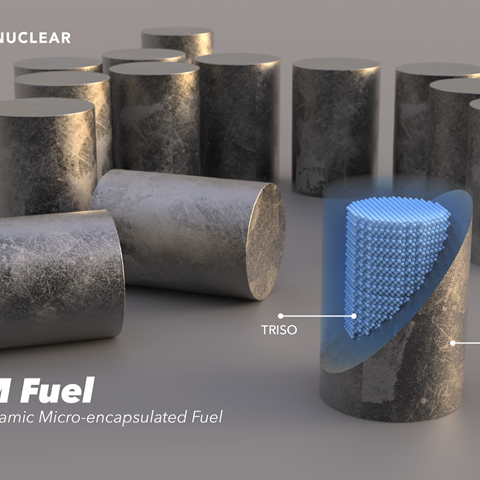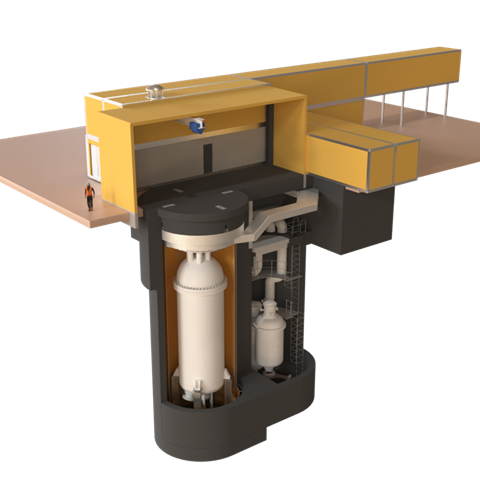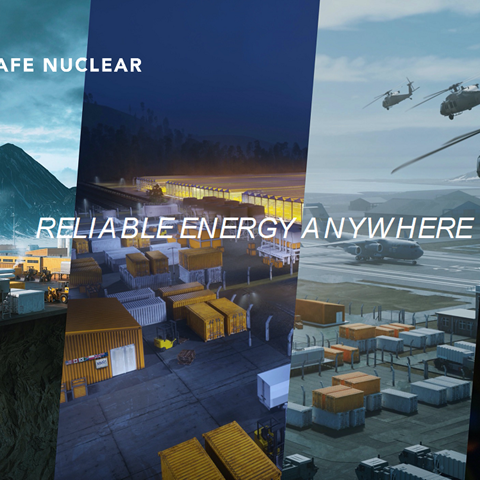We make use of cookies. When you click on agreed you are giving us your permission to do so. Please read our cookie statement for more information.
Interview
Interview with Mark Davies, Vice President – Fuel at USNC
26 April 2021
The first advanced reactor system that has been allocated a site in the Western part of the world. The USNC MMR is an inherently safe and modular system, designed to produce energy or heat for industrial processes or hydrogen production. Mark Davies, Vice President – Fuel at USNC, gives an interview on his experience in nuclear technology, his current work at USNC and the future including the MMR technology.
How did you get into the nuclear field to begin with?
I joined the UK Atomic Energy Authority Thermal Reactor division, shortly after university. I have spent most of my career in structural integrity and materials and in particular the assessment of graphite moderators. I had a two year sabbatical at ESKOM at the Koeberg PWR in Cape town. About a year or so ago, I became vice president for commercial fuel for USNC developing TRISO fuel in a Silicon carbide matrix.

Is it a big jump from graphite to fuel?
Yes, I knew a lot about TRISO fuel but I knew little about fabrication in an FCM matrix. However the work is much broader than the science and technology of the fuel, it’s organizing large contracts to for HALEU supply and transport, TRISO fabrication and to develop automation equipment for engineering scale production of FCM. The most significant part of the job is developing a qualification program and we are working with NRG to deliver an irradiation qualification programme starting with concept design and hopefully commence irradiation June 2022.
What makes the USNC concept unique?
MMR is an inherently safe design which due to its fuel design and compactness can provide resources to industrial processes.
USNC MMR is an inherently safe reactor design but our fuel design will mean that the source term in the primary coolant is extremely low which limits the emergency planning zone requirement to the site boundary around the nuclear plant. The small EPZ will enable collocation adjacent to industrial applications where we can supply heat for industrial processes and hydrogen production.
In addition, solar salt is used as an intermediate thermal storage in the MMR system. This effectively decouples the reactor from the load application - if the application demand turns down, the reactor can continue to operate and heat is stored in the salt tanks. Alternatively, if the reactor trips for any reason, the thermal salt system can still power the application until the reactor is recovered.
How did your work at EDF influence your work at USNC?
The AGRs are coming to the end of their life. It’s not economic to continue to make more and more difficult safety cases. So far the EDF team, which embraced consultant support, has done well to manage their way through a difficult safety case production and agreement with the regulator that they continue to safely operate.
So my experience with EDF is that they have a very professional attitude and a strong nuclear culture and I feel like I’ve improved as an individual, having been absorbed some of the systems and strategies and support obtained from senior staff at EDF. This impacts my everyday work at USNC.
Which collaborations do you think were instrumental to develop the MMR system?
The other important innovation USNC uses besides FCM fuel is Solar Salt. We reached out to some concentrated solar plant operators for their experience with salt storage, which has helped. We worked in detail with KAERI, from South Korea, for core design support. We’re also collaborating with people in terms of delivery, engineering, procurement and construction aspects. We work closely with component suppliers, such as Howden, to deliver a fully submerged circulator. We also have a partnership with Synthos, a large petrochemical plant in Poland and jointly submitted a bid using nuclear heat to produce bulk hydrogen as a European project. We will use our process heat with a thermochemical water splitting process or a solid oxide electrolyzer cell technology to produce bulk hydrogen at a competitive price. So we’re working with a thermochemical water splitting specialist and also a solid oxide electrolyzer cell technology to do that as well.

What infrastructure is needed to get to the USNC production facility, and what infrastructure is needed to build them on the final building site?
At the moment we’re developing a bespoke fuel fabrication facility and on engineering scale automation of fuel production. For plant infrastructure on site, we’re working with other partners that already have hydrogen production technology that operate within our temperature range.
What is your plan to export the MMR technology?
USNC will build a demonstrator in Canada, because our launch market is remote mining communities in northern Canada. They need to transport the diesel up to those sites at the moment. Our system doesn’t refuel and has a lifetime of 20 years. If there’s more life in the mine, we could refuel.
After delivering to that market USNC will pivot into process heat and hydrogen production in Europe to decarbonize industrial clusters. MMR can double power production without changing the layout. So an MMR could produce twice the power with the same amount of fuel but we’d have to refuel in ten years instead of in twenty years.

What are the most important lessons learnt from existing nuclear energy technologies for USNC?
Safety is paramount, USNC have designed an inherently safe system, which impacts competitiveness. However, this is recovered to some extent by removing unnecessary engineered safety system, because its inherently safe and by being small we can modularize, so we can improve the quality of the products going to the site, reduce the site construction time and reduce the capital cost of each MMR.
The inherent design is underpinned by high integrity fuel. TRISO fuel is a huge historical success that’s not been widely used. The Germans, Japanese and Americans have made TRISO fuel very successfully but for whatever reason, HTRs have never taken off. TRISO is a very robust fuel and when incorporated in FCM can make a serious contribution to decarbonizing our industrial applications and hitting the zero carbon target by 2050.
